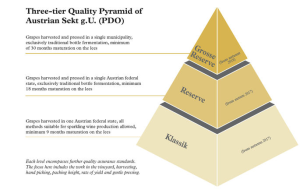As serious students of wine might remember, Austria updated it wine laws—in quite a major overhaul—in July of 2016. As part of this mashup, the laws concerning PDO Austrian Sekt were revised, and as of this the 2017 harvest, these laws have been refined and come into effect. As such, it seems like a good time to take a deep dive into the new laws concerning bubbles from Austria!
The Basics: These regulations apply to “Austrian Sekt with Protected Designation of Origin” (Österreichischer Sekt mit geschützter Ursprungsbezeichnung [gU]). Such wines must be designated on the labeled as Qualitätsschaumwein or Sekt and one of the following terms: Klassik, Reserve, or Grosse Reserve (Grand Reserve). These wines must be produced using just the 36 grape varieties designated for use in Austrian Quality wines, although specific grapes or blends are not mandated. The carbon dioxide dissolved in the bottle must be a minimum of 3.5 atm. (Click here for a list of the: The Austria 36-Grape Varieties)
Austrian Sekt Klassik:
- May be produced using any sparkling wine production method
- Grapes must be sourced from one single Austrian State, which must serve as the wine’s appellation of origin
- Must be vinified in Austria
- Minimum 12.5% abv
- Minimum of 9 months aging on the lees; may be released to the consumer after October 22 of the year following harvest
- All styles (red, white, rosé) and all sweetness levels are allowed
Austrian Sekt Reserve:
- Must be made using the traditional method of sparkling wine production with whole-cluster pressing
- Grapes must be sourced from one single Austrian State, which must serve as the wine’s appellation of origin
- Must be hand-harvested
- (No regulations regarding abv)
- Minimum of 18 months aging on the lees; may be released to the consumer after October 22 of the second year following harvest
- Must be brut-level sweetness or drier
- May be red, white, or rosé, but rosé must be produced using red grapes only
Austrian Sekt Grosse Reserve (Grand Reserve):
- Must be made using the traditional method of sparkling wine production with whole-cluster pressing
- Grapes must be sourced from one single Austrian winegrowing community, vineyard designation from registered sites permitted
- Must be hand-harvested
- (No regulations regarding abv)
- Minimum of 30 months aging on the lees; may be released to the consumer after October 22 of the third year following harvest
- Must be brut-level sweetness or drier (maximum 12 g/L R.S.)
- May be red, white, or rosé, but rosé must be produced using red grapes only
For many of us, it seems like these regulations come just in time for the winter holidays, giving us one more reason to reach for the bubbly!
References/for more information:


